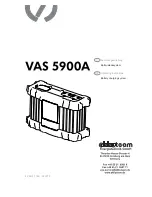
4. Installation
The DC (PV) input is not isolated from the battery circuit. Therefore the PV, battery and control circuit are
considered hazardous and should not be user accessible.
For proper temperature compensated battery charging the ambient temperature of the solar charger and the
battery must be within 5°C (9°F).
The battery and PV connections must be guarded against inadvertent contact. Install the solar charger in an
enclosure or install the optional
4.1. Mounting
Mount the solar charger vertically on a non-flammable substrate, with the electrical terminals facing downwards.
If the optional MPPT WireBox is used, affix the steel WireBox base to the solar charger before the solar charger is mounted into
its final position. For more information see the MPPT WireBox manual.
of this manual contains the dimension drawing of the solar charger, this drawing also indicates the mounting
holes.
Observe a minimum clearance of 10cm under and above the solar charger for optimal cooling.
Mount the solar charger close to the battery, but never directly above the battery. This to prevent damage to due to gassing of the
battery.
Avoid ambient temperature differences of more than 5°C between the solar charger and the battery. These
temperature differences can lead to incorrect temperature compensated charging, which can reduce the
battery lifetime.
If large temperature differences or extreme ambient temperature conditions are expectedd use a direct battery
temperature sense source like the Smart Battery Sense or a BMV or SmartShunt equipped with a temperature
sensor.
4.2. Battery
The battery supply must be protected by a fuse as per below table.
Solar charger type
Minimum battery fuse rating
Maximum battery fuse rating
MPPT 100/30
35A
40A
MPPT 100/50
55A
70A
For Canada the battery fuse must comply with the C22.2 standards.
The battery installation must be done in accordance with the local storage battery rules. For Canada this is the
Canadian Electrical Code, Part I.
Use flexible multi stranded copper cable for the battery connections Also see chapter
4.3. PV array
The solar charger can be used with a PV configuration that satisfies both these two conditions:
• The maximum open circuit PV voltage can not exceed 100V
• The nominal PV voltage should be at least 5V higher than the battery voltage.
The PV array can consist of mono- or poly-crystalline panels.
The solar panels are connected in series, in parallel or in series/parallel. See below figure for examples of these configurations.
MPPT solar charger manual
Page 9
Installation













































